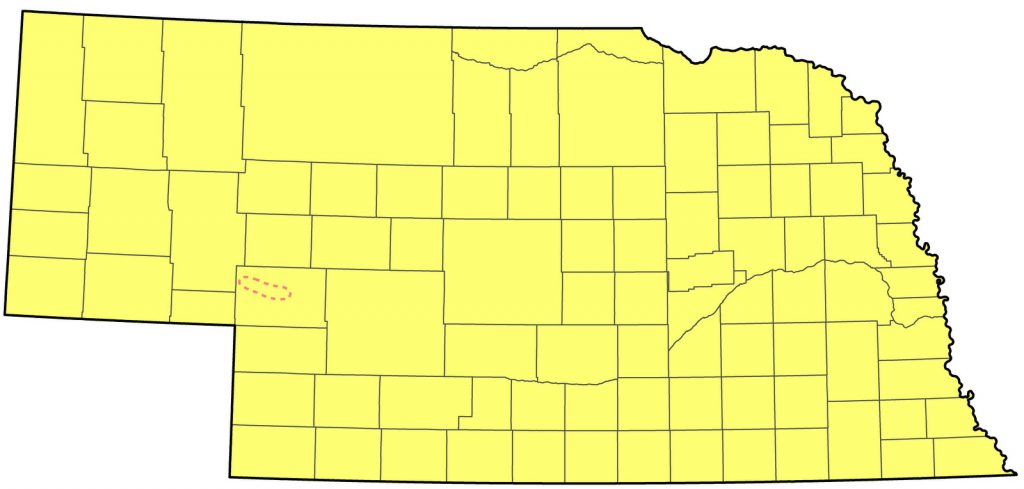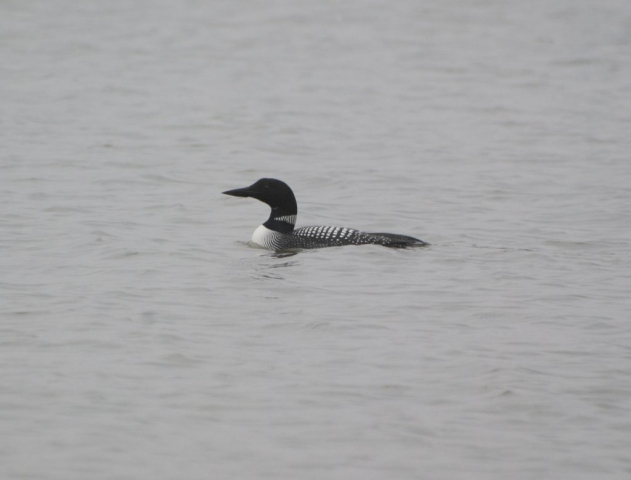Gavia immer
Status: Fairly common regular spring and fall migrant east and central, uncommon west. Locally uncommon regular summer visitor west and central, rare east. Rare casual winter visitor statewide.

Documentation: Specimen: UNSM ZM7652, 30 Oct 1919 Lancaster Co.
Taxonomy: No subspecies are recognized (AviList 2025).
Spring: Mar 10, 11, 12 <<<>>> Jun 2, 3, 5 (east and east-central); Apr 4, 4, 4 <<<>>> summer (west and west-central)
Earlier dates in west and west central, all but one at Lake McConaughy, Keith Co, are 21 Mar 2008, 22 Mar 2016, 26 Mar 2017, 28 Mar 1999, 31 Mar 2018, and 2 Apr 2003. Three were at Sutherland Reservoir, Lincoln Co 19 Mar 2025.
For later dates, see Summer.
Most migrants pass through the east, with a peak in Apr and early May. This species has a primary migration route from the north-central United States and adjacent Canada to the Gulf Coast that encompasses Iowa (Evers et al 2020); the higher numbers observed in eastern Nebraska likely represent the western portion of this migration route. Very late for birds in alternate plumage were singles in Sarpy Co 26 May 2014, Pierce Co 31 May 2013, 1 Jun 2014 Cedar Co, and 9 Jun 2018 Sarpy Co. Arrival is later in the west; late dates in the west are generally of immatures which linger and sometimes summer.
- High counts: 17 at Branched Oak Lake, Lancaster Co 17 Apr 2018, 15 there 18 May 2017, 15 at Gavin’s Point Dam in Cedar Co 9 Apr 2023, and 14 at Lake McConaughy 26 Apr 1991 (Rosche 1994).
Summer: Since the 1990s this species has become regular in summer on western reservoirs, as in the Keith Co area, where “The many summer records are of non-breeding individuals; no nesting is known for the area.” (Brown and Brown 2001). In the east however, it is less than annual in summer. About 25% of Jun-Sep reports are from the east.
Most summering birds are in immature plumages, suggesting incomplete spring migration by immature non-breeding birds. Occasional adults are seen beginning in mid-Jun, possibly failed breeders that moved south before the typical fall migration period.
Fall: Sep 24, 24, 26 <<<>>> Dec 4, 6, 6
Earlier dates are 11-19 Sep 2023 (2) Lake Alice, Scotts Bluff Co, 20 Sep 2021 Sutherland Reservoir, Lincoln Co.
Later dates are 7-17 Dec 2022 Sutherland Reservoir, Lincoln Co, 12 Dec 2020 Holmes Lake, Lancaster Co, 13-14 Dec 2023 Harlan County Reservoir, Harlan Co, 14 Dec 2019 Harlan Co, 14 Dec 2022 Harlan Co, 15 Dec 2016 Harlan Co, 16 Dec 2024 Harlan County Reservoir, 19 Dec 2020 Branched Oak Lake, Lancaster Co, 21 Dec 2020 Lincoln Co, 22 Dec 2023 Lake McConaughy, 23 Dec 2017 Lake Wanahoo, Saunders Co, 25 Dec 2017 Lake McConaughy, 27 Dec 2007 juvenile Sutherland Reservoir, 27 Dec 2014 Lake McConaughy, 27-29 Dec 2007 Lake McConaughy, 28 Dec 1932 at Harlan County Reservoir (Swenk 1933), 29 Dec 2013 Lake McConaughy, 1 Jan 1952 Keith Co (Rapp 1952), 2 Jan 2011 Lake McConaughy, and 3 Jan 2022 Lake McConaughy.
The fall migration is leisurely as in spring, with most occurrence dates evenly distributed through Oct and Nov.
- High counts: 30 at Lewis and Clark Lake, Knox and Cedar Cos 4 Nov 2012, 27 at Harlan County Reservoir 1 Nov 1998, and 22 at Lake Ogallala, Keith Co 7 Nov 1998. A total of about 80 passed through in fall 2012.
Winter: Mid-winter (Jan-Feb) records are few, presumably due to a lack of open water. There are six:
1999-2000 adult and immature apparently wintered at Lake McConaughy (Silcock 2000)
16 Jan 2019 Lake McConaughy (Jorgensen eBird.org)
Feb 1991 Douglas-Sarpy Cos (Korpi 1991)
15 Feb 1995 North Platte NWR (Silcock 1995)
16-18 Feb 2017 immature photographed at Branched Oak Lake (Silcock 2017)
24 Feb 1995 Cass Co (Grzybowski 1995).
Images
Abbreviations
NWR: National Wildlife Refuge
UNSM: University of Nebraska State Museum
Literature Cited
AviList Core Team, 2025. AviList: The Global Avian Checklist, v2025. https://doi.org/10.2173/avilist.v2025.
Brown, C.R., and M.B. Brown. 2001. Birds of the Cedar Point Biological Station. Occasional Papers of the Cedar Point Biological Station, No. 1.
Evers, D.C., J.D. Paruk, J.W. McIntyre, and J.F. Barr. 2020. Common Loon (Gavia immer), version 1.0. In Birds of the World (S. M. Billerman, Editor). Cornell Lab of Ornithology, Ithaca, NY, USA. https://doi.org/10.2173/bow.comloo.01.
Grzybowski, J.A. 1995. Southern Great Plains Region. Field Notes 49: 162-164.
Korpi, R.T. 1991. Spring 1991 Occurrence Report. NBR 59: 63-98.
Rapp, W.F. Jr. 1952. Twenty-eighth Annual Cooperative Spring Migration Report. NBR 20: 62-83.
Rosche, R.C. 1994. Birds of the Lake McConaughy area and the North Platte River valley, Nebraska. Published by the author, Chadron, Nebraska, USA.
Silcock, W.R. 1995. Winter Field Report, December-February 1994-95. NBR 63: 14-23.
Silcock, W.R. 2000. Winter Field Report, December 1999 to February 2000. NBR 68: 9-2
Silcock, W.R. 2017. Winter Field Report, Dec. 2016- Feb. 2017. NBR 85: 2-31.
Swenk, M.H. 1933. A brief synopsis of the birds of Nebraska. I. Loons. NBR 1: 87-90.
Recommended Citation
Silcock, W.R., and J.G. Jorgensen. 2025. Common Loon (Gavia immer ). In Birds of Nebraska — Online. www.BirdsofNebraska.org
Birds of Nebraska – Online
Updated 23 Aug 2025

